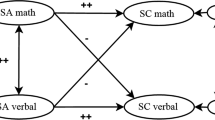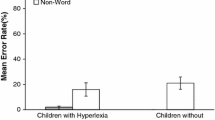Abstract
Twelve mildly mentally handicapped and twelve nonhandicapped children were exposed to two separate stimulus equivalence procedures, one employing neutral, arbitrary stimuli (abstract shapes) and the other employing loaded stimuli (words). The neutral equivalence procedure served as a control measure, and passing the neutral test was a prerequisite for a subject’s inclusion in the study. The loaded equivalence procedure incorporated words pertinent to academic self-concept (“Slow” and “Able”) as B stimuli, and personal names (subject’s own name and a fictional name) as C stimuli. Experimentally induced equivalence relations linked the subjects’ own names to the word Able. A statistically significant difference in performance between mildly mentally handicapped and nonhandicapped subjects was obtained, with mildly mentally handicapped subjects producing significantly lower levels of equivalence responding on this test (i.e., failing to match their own name to the word Able). The results suggest that preexperimentally established relations between the handicapped subjects’ own names and the descriptive term Slow may have disrupted the formation of experimentally induced equivalence relations for some of the handicapped subjects.
Similar content being viewed by others
References
BARNES, D. (1994). Stimulus equivalence and relational frame theory. The Psychological Record, 44, 91–124.
BARNES, D., BROWNE, M., SMEETS, P. M., & ROCHE, B. (1995). A transfer of functions and a conditional transfer of functions through equivalence relations in three- to six-year-old children. The Psychological Record, 45, 405–430.
BARNES, D., & HOLMES, E. (1991). Radical behaviorism, stimulus equivalence, and human cognition. The Psychological Record, 41, 19–30.
BARNES, D., & KEENAN, M. (1993). A transfer of functions through derived arbitrary and nonarbitrary stimulus relations. Journal of the Experimental Analysis of Behavior, 59, 61–81.
BARNES, D., MCCULLAGH, P. D., & KEENAN, M. (1990). Equivalence class formation in non-hearing impaired children and hearing impaired children. The Analysis of Verbal Behavior, 8, 19–30.
BATTLE, J., & BLOWERS, R. (1982). A longitudinal comparative study of the self esteem of students in regular and special education classes. Journal of Learning Disabilities, 15, 100–102.
BELOFF, H. (1992). Mother, father and me: Our Iq. The Psychologist, July, 309–311.
CARROLL, J. L., FRIEDRICH, D., & HUND, J. (1984). Academic self-concept and teachers perceptions of normal, mentally retarded and learning disabled elementary students. Psychology in the Schools, 21, 343–348.
CHOVAN, W. L., & MORRISON, E. R. (1984). Correlates of self-concept among variant children. Psychological Reports, 54, 536–538.
DEVANY, J. M., HAYES, S. C., & NELSON, R. O. (1986). Equivalence class formation in language-able and language-disabled children. Journal of the Experimental Analysis of Behavior, 46, 243–257.
DYMOND, S., & BARNES, D. (1994). A transfer of self-discrimination response functions through equivalence relations. Journal of the Experimental Analysis of Behavior, 62, 251–267.
DYMOND, S., & BARNES, D. (1995). A transformation of self-discrimination response functions in accordance with the arbitrarily applicable relations of samness, more-than, and less-than. Journal of the Experimental Analysis of Behavior. 64, 163–184.
FIELDS, L., & VERHAVE, T. (1987). The structure of equivalence classes. Journal of the Experimental Analysis of Behavior, 48, 243–257.
GIBBONS, F. X. (1985). Stigma perception: Social comparisons among mentally retarded persons. American Journal of Mental Deficiency, 90, 98–106.
HAYES, S. C. (1987). A contextual approach to therapeutic change. In N. Jacobson (Ed.), Psychotherapists in clinical practice: Cognitive and behavioral perspectives (pp. 327–387). New York: Guildford.
HAYES, S. C. (1992). Verbal relations, time, and suicide. In S. C. Hayes & L. J. Hayes (Eds.), Dialogues on verbal behavior. Reno, NV: Context Press.
HAYES, S. C., & WILSON, K. G. (1993). Some applied implications of a contemporary behavior-analytic account of verbal events. The Behavior Analyst, 16, 283–301.
JONES, C. J. (1985). Analysis of the self concepts of handicapped children. Remedial and Special Education, 6, 32–36.
JONES, C. J. (1992). Enhancing self-concepts and achievement of mildly handicapped students: Learning disabled, mildly mentally retarded and behavior disordered. Springfield, IL: Charles C.Thomas.
KOHLENBERG, B. S., HAYES, S. C., & HAYES, L J. (1991). The transfer of contextual control over equivalence classes through equivalence classes: A possible model of social stereotyping. Journal of the Experimental Analysis of Behavior, 56, 505–518.
MOXON, P. D., KEENAN, M., & HINE, L. (1993). Gender role stereotyping and stimulus equivalence. The Psychological Record, 43, 381–394.
PILGRIM, C., & GALIZIO, M. (1990). Relations between baseline contingencies and equivalence probe performances. Journal of the Experimental Analysis of Behavior, 54, 213–224.
POLLOWAY, E. A., & SMITH, J. D. (1988). Current status of the mild mental retardation construct: identification, placement, and programs. In M. C. Wang, M. C. Reynolds, & H. J. Walberg (Eds.), Handbook of special education: Research and practice (Vol. 2). U.K.: Pergamon Press.
SAUNDERS, R. R., SAUNDERS, K. J., KIRBY, K. C., & SPRADLIN, J. E. (1988). The merger and development of equivalence classes by unreinforced conditional selection of comparison stimuli. Journal of the Experimental Analysis of Behavior, 50, 145–162.
SAUNDERS, R. R., WACHTER, J., & SPRADLIN, J. E. (1988). Establishing auditory stimulus control over an eight-member equivalence class via conditional discrimination procedures. Journal of the Experimental Analysis of Behavior, 49, 95–115.
SIDMAN, M. (1990). Equivalence relations: Where do they come from? In D. E. Blackman & H. Lejeune (Eds.), Behaviour analysis in theory and practice. U.K.: Lawrence Erlbaum.
SMEETS, P. M. (1993). Emergent simple discrimination in children: Preference for nonpreferred stimuli. The Quarterly Journal of Experimental Psychology, 46B, 321–343.
SZIVOS, S. E., & GRIFFITHS, E. (1990). Group processes involved in coming to terms with a mentally retarded identity. Mental Retardation, 28, 333–341.
WATT, A., KEENAN, M., BARNES, D., & CAIRNS, E. (1991). Social categorization and stimulus equivalence. The Psychological Record, 41, 33–50.
Author information
Authors and Affiliations
Additional information
We thank three anonymous reviewers for their constructive criticisms, and the staff and students of SI. Ita’s and SI. Josephs Special School and Rathmorrell National School, Co. Kerry, for their enthusiastic cooperation.
Rights and permissions
About this article
Cite this article
Barnes, D., Lawlor, H., Smeets, P.M. et al. Stimulus Equivalence and Academic Self-Concept Among Mildly Mentally Handicapped and Nonhandicapped Children. Psychol Rec 46, 87–107 (1996). https://doi.org/10.1007/BF03395165
Published:
Issue Date:
DOI: https://doi.org/10.1007/BF03395165




